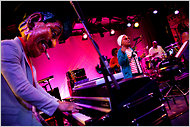Feet’s Too Big? No Problem; Everyone Dances Here

Once, a special event in jazz meant something warm and secretive and spontaneous: two guys who hadn’t seen each other in a while, improvising several choruses together. But lately — since the early 1990s, when jazz became fixed in the world of arts grants and cultural institutions — it has often meant something more structured, official and imposing: heady written music, presented before a theater audience, sometimes elaborated with text or image or drama, program-noted and documented and ready to be reproduced elsewhere.
Now it can, and should, mean something like what happened over the weekend at Harlem Stage Gatehouse. On Friday and Saturday Jason Moran and Meshell Ndegeocello led a band of jazz musicians through tunes that started in fragments of Fats Waller songs, or songs Waller played, or sometimes just the words from songs he played: “Honeysuckle Rose,” “Jitterbug Waltz,” “Your Feet’s Too Big,” “Two Sleepy People.” They started there but ended up in fragmented and repeated funk vamps cued by Mr. Moran’s Fender Rhodes electric piano and Ms. Ndegeocello’s chanting voice.
The Moran-Ndegeocello show was commissioned by Harlem Stage as part of its first annual Harlem Jazz Shrines Festival, a weeklong chain of concerts, exhibitions and talks that ended on Sunday. This event — “Fats Waller Dance Party: Small’s Paradise,” paying tribute both to the spirit of Waller and to a club he played in Harlem — will most likely happen again, in other cities. But it didn’t really matter; the show felt both site-specific and spur of the moment. The band geared itself toward dancing and sounded easygoing its first time out.
With the first notes in Friday’s early set, a crew of hired dancers appeared on the floor, moving in updated swing-style body language. First they were a spectacle unto themselves; then they beckoned the front tables to dance with them; then they became eclipsed by the larger scene, as half of the people in the room got up and came forward.
The professionals worked their impressive routines, but nobody grew cowed or passive around them. The room felt easy and real and radiant: same-sex couples, mixed-race couples, grandparents, sharply dressed college students.
The Fats Waller songs served only as suggestions. In a few places, the rest of the band — including the singer Lisa Harris, the bassist Mark Kelley, the trombonist Corey King and the trumpeter Leron Thomas, who are all originally from Houston, like Mr. Moran — dropped out while Mr. Moran broke out in stride-piano patterns or repeated a fragment of an old melody.
Then the band built on those fragments, in rhythms coming out of 1960s-and-beyond dance music: Motown, house, hip-hop. (The hard grooves came from the drummer Charles Haynes, a jazz musician who has toured with Kanye West and Lady Gaga.)
For a while, playing and dancing, Mr. Moran wore a huge papier-mâché mask of Waller’s head — fedora hat, grin, cigarette in the left corner of the mouth — made by the Haitian artist Didier Civil. It was all joyous and foolish and graceful: somehow both exceptional and no big deal.